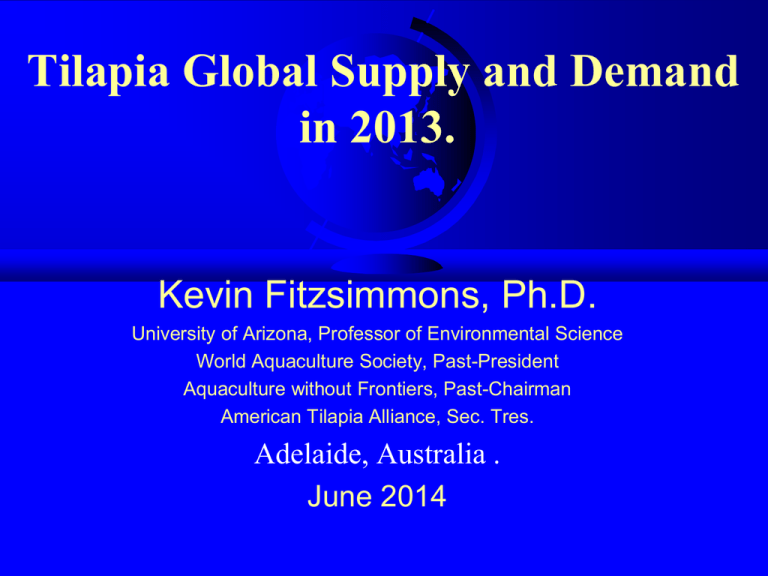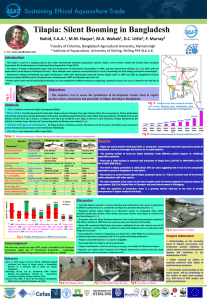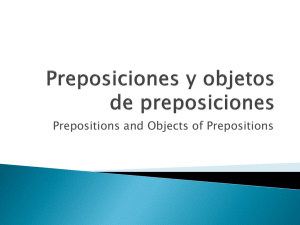Tilapia Aquaculture * An Overview: Nutrition and Feed Tchnology
advertisement

Tilapia Global Supply and Demand in 2013. Kevin Fitzsimmons, Ph.D. University of Arizona, Professor of Environmental Science World Aquaculture Society, Past-President Aquaculture without Frontiers, Past-Chairman American Tilapia Alliance, Sec. Tres. Adelaide, Australia . June 2014 Tilapia: continuing to increase in popularity globally • • • Tilapias are second only to the carps as a farmed food fish. In 2012 the global volume of farmed fish exceeded global volume of beef for the first time (FAO) Tilapia have unique characteristics that will facilitate its continued growth to someday surpass carp production. Global production of some major farmed fishes 4,500,000 Metric tons per year 4,000,000 3,500,000 3,000,000 Tilapia Catfish Salmon 2,500,000 2,000,000 1,500,000 1,000,000 500,000 0 1980 1990 2000 2008 2010 2011 2012 World Tilapia Production of 4,677,613 mt in 2013 1,800,000 1,600,000 1,400,000 1,200,000 1,000,000 800,000 600,000 400,000 200,000 0 2008 Tilapia exports from China Sales volume = 224,359 mt Russia 8% EU 5% Others 7% SubSahara Africa 10% US 54% Mexico 16% 2012 Tilapia exports from China Sales Others 20% EU 6% Russia 6% SubSahara Africa 2% Mexico 10% US 56% Farm gate prices for tilapia to Chinese farmers Ex-farm prices for whole, live tilapia, China, 500-800 grams Nov. 2013: RMB 10.0 ($1.60/kg) Global production of tilapia Aquaculture Fishery 5,000,000 4,500,000 3,500,000 3,000,000 2,500,000 2,000,000 1,500,000 1,000,000 500,000 2012 (est) 2010 2008 2006 2004 2002 2000 1998 1996 1994 1992 1990 1988 1986 0 1984 Metric tons 4,000,000 Top Ten Seafoods (U.S.) per capita (lbs) 2000 2001 T una 3 Shr i mp 3 Shr i mp 3.2 T una 2.9 2002 2003 2004 2005 2006 2007 2008 2009 2 0 11 2 0 10 2 0 12 Shr i mp 3.7 Shr i mp 4.0 Shr i mp 4.2 Shr i mp 4.1 Shr i mp 4.4 Shr i mp 4.1 Shr i mp 4 Shr i mp 4.1 Shr i mp 4.0 Shrimp 4.2 Shrimp 3.8 T una 3.1 T una T una 3.1 T una T una T una Tuna Pol l ock 1.6 Sal mon 2.0 Sal mon 2.0 3.4 T una 3.4 Sal mon 2.2 Sal mon 2.2 2.9 T una 2.7 T una 2.8 Sal mon 2.4 Sal mon 2.0 Sal mon 2.4 Sal mon 1.8 2.5 Sal mon 2.0 2.7 Sal mon 2.0 2.6 Tuna 2.4 Salmon 2.0 Salmon 2.0 Sal mon 1.5 Pol l ock 1.2 Pol l ock 1.1 Pol l ock 1.7 Pol l ock 1.7 Pol l ock 1.5 Pol l ock 1.6 Pol l ock 1.7 Pol l ock 1.34 Pol l ock 1.45 T i l api a 1.45 Pollock 1.3 T ilapia 1.5 Catf i sh 1.1 Catf i sh 1.1 Catf i sh 1.1 Catf i sh 1.1 Catf i sh 1.1 Catf i sh 1.0 T i l api a 1.0 Tilapia 1.3 Cod 0.8 Cod 0.6 Cod 0.7 Cod 0.6 T i l api a 1.14 T i l api a 1.19 T i l api a 1.21 Pol l ock 1.2 T i l api a 0.7 T i l api a 0.8 Catf i sh 0.97 Catf i sh 0.90 Catf i sh 0.92 Catf i sh 0.85 Catf i sh 0.8 Cl ams 0.5 Cl ams 0.5 Cr abs 0.6 Cr abs 0.6 Cod 0.6 Cr abs 0.4 Cr abs 0.4 Cl ams 0.5 T i l api a 0.5 Cr abs 0.6 Fl atf i sh 0.4 Fl atf i sh 0.4 T i l api a 0.4 Cl ams 0.5 Cl ams 0.5 Cr abs 0.6 Cr abs 0.7 Cr abs 0.68 Cr abs 0.61 Cr abs 0.59 Cr abs Cod 0.6 Cod Cod 0.5 Cl ams 0.4 Cl ams 0.4 Cod 0.47 Cod 0.44 Cod 0.42 Cl ams 0.45 Fl atf i sh 0.43 Cl ams 0.41 0.6 0.5 Pangasi us 0.4 Scal l ops 0.3 T i l api a 0.4 Fl atf i sh 0.3 Scal l ops 0.3 Scal l ops 0.3 Scal l ops 0.3 Scal l ops 0.3 Fl atf i sh 0.32 Cl ams 0.42 Pangasi us 0.35 Cl ams 0.35 T i l api a 0.3 Pollock 1.2 Pangasius 0.6 Pangasius 0.7 Catfish 0.6 Crabs 0.5 Crabs 0.5 Cod Cod 0.5 0.5 Catfish 0.5 Clams 0.3 Clams 0.3 US Consumption of tilapia from domestic and imported sources 700,000 500,000 400,000 Domestic 300,000 200,000 100,000 2012 2010 2008 2006 2004 2002 2000 1998 1996 1994 1992 0 1990 Tilapia (000's of kg of live weight) 600,000 Imports Percentage of US finfish grocery sales: weekly sales averaged $608 per store US Tilapia consumption (imports and domestic) 437,000 mt of live weight (equivalent) - 2007 453,264 mt of live weight (equivalent) – 2008 465,953 mt of live weight (equivalent – 2009) 579,443 mt of live weight (equivalent – 2010) 513,361 mt of live weight (equivalent – 2011) 613,406 mt of live weight (equivalent – 2012) 700,000 600,000 400,000 300,000 200,000 2012 2010 2008 2006 2004 2002 2000 1998 1996 1994 1992 1990 0 1988 100,000 1986 Metric tons 500,000 $696,085,981(2009) $842,866,006(2010), $838,349,634 (2011) $986,127,852 (2012) Value Value ofof Tilapia Tilapia product product forms forms imported imported to to the the U.S. U.S. 2002 $1,200,000,000 $200,000,000 $180,000,000 $1,000,000,000 $160,000,000 $120,000,000 $600,000,000 $100,000,000 Whole Frozen Whole Frozen Fillet Frozen Fillet Frozen Fillet Fresh Fillet Fresh $80,000,000 $400,000,000 $60,000,000 2001 2012 2011 2000 2010 2009 2008 1999 2007 2006 1998 2005 2004 1997 2003 Fillet Frozen Fillet Fresh 2002 1996 2000 1999 1995 1998 1997 1994 1996 1995 1994 $20,000,000 $0 $0 1993 1993 Whole Frozen 1992 $ US $200,000,000 $40,000,000 2001 $ US $140,000,000 $800,000,000 2002 US Sales of tilapia • • • • • Imports to US in 2012 were $986,127,852 US production of 28,000,000 lbs at farm 2012 US tilapia farm-gate sales were $84,000,000 2012 US Tilapia Sales estimate – $986,127,852 + $84,000,000 = $ 1,070,127,852 Selective breeding and genetic improvements • • • Excellent breeding programs - G.I.F.T. - Malaysia - Acuaplan - Mexico - Genomar - Brasil and Norway - Chitralada – Thailand - TabTim – Thailand (CP Group) - GIFT Excell – Philippines - Molobicus - Philippines - GIFT Bangladesh Several in Israel YY Supermale - Philippines and Swansea, Egypt and Indonesia Genetic improvements in tilapia (From: Mair, G., 2002) Tilapia Genome Project • • • • • • March 2011 - First assembly of the tilapia genome Oreochromis niloticus – Nile Tilapia http://www.broadinstitute.org/ftp/pub/assemblies/fi sh/tilapia/Orenil1/ Matching many segments to those known from other fish Publically available and freely accessible Next frontier of genetic program for tilapia The YY male technology (GMT®) Regions of rapid production growth • • • • • • Vietnam – conversion of catfish cages to tilapia in Mekong, and culture in all regions Indonesia – cage culture, polycultures, rice culture Malaysia – government support and private sector investment Bangladesh – government support and private sector investment Brasil – lots of available water, labor, land, feed Thailand – better reporting, shrimp polyculture • Mexico – continued intensification, some govt support, large and small private investments • Sub-Saharan Africa - commercialization Mexico 4623 licensed farms 20,000 ton Dos Lagos farm in Chiapas Second farm now started, also by Regal Springs Pathways in the use of tilapia as biomanipulator (and disease control?) in shrimp farms for Vibrios and EMS Promotion of Chlorella dominance IMPROVED SEDIMENT QUALITY Feeding on organic waste Bioturbation of sediment IMPROVED WATER QUALITY Production of natural antimicrobials SUPRESSION OF GROWTH OF V. harveyi and V. parahaemolyticus ? Stocking and harvest schedule Improvements in packaging Traditional product forms Yangon BBQ tilapia Mexican-American street foods Courtesy: Randall Brummett Byproducts - Tilapia Leather Pet treats Tilapia Orange Juice Tilapia pedicures and manicures Global Tilapia Market Trends Prices have been constant, only fresh fillets have increased significantly, will not see increases beyond inflation 8 7 Fresh fillet Frozen fillet Whole Frozen Live 5 4 3 2 1 2012 2011 2010 2009 2008 2007 2006 2005 2004 2003 2002 2001 2000 1999 1998 1997 1996 1995 1994 1993 0 1992 $/kg 6 Tilapia Global Aquaculture Production 3000 6 2500 5 2000 4 1500 3 1000 2 500 1 0 0 2010E 2009 2008 2007 2006 2005 2004 2003 2002 2001 2000 1999 1998 1997 1996 1995 1994 1993 1992 1991 1990 Sources: 1990-2009: FAO and Kevin Fitzsimmons; 2010-2012: Average of Helga Josupeit and Kevin Fitzsimmons estimates; 2013: Kevin Fitzsimmons; Prices US import frozen tilapia Jan- Jun: NMFS 2013F 7 2012F 3500 2011F 4000 REAL PRICE (USD/KG) 8 1000 METRIC TONNES 35 Farmed Mexican tilapia fillets in Tucson, Arizona Safeway $15/kg Global Aquaculture Tilapia Sales • For year 2000 =US $ 1,615,321,000 (FAO FishStat 2007) • 2005 sales = $ 2,457,312,000 (FAO FishStat 2007) • 2010 sales = $ 5,680,410,000 (FAO FishStat 2012) • 2012 sales = $ 7,656,257,000 (FAO FishStat 2014) • 2013 sales > $ 9,000,000,000 2013 (est) 2012 2011 2010 2009 2008 2007 2006 2005 2004 2003 2002 Metric tons Bangladesh tilapia aquaculture 150,000 100,000 50,000 0 2015 (est) 2014 (est) 2013 (est) 2012 (est) 2011 2010 2009 2008 2007 2006 2005 2004 2003 2002 Metric tons (000) Future global tilapia aquaculture 5,000 4,500 4,000 3,500 3,000 2,500 2,000 1,500 1,000 500 0 ISTA 11 Surabaya, Indonesia In conjunction with WAS Asia-Pacific Chapter Regal Springs, Surya University, Matahari Sakti Feeds, AquaFish Innovation Lab, WorldFish, and Aquaculture without Frontiers May 2016 Conclusions • • • Tilapia has long been called the aquatic chicken. Instead…... The “terrestrial tilapia” Conclusions • • • Global tilapia production was 4,507,002 metric tons in 2012 (FAO, 2014), should exceed 4,800,000 MT in 2014. (6% growth) Constantly improving farming, processing and packaging for food safety, quality assurance, traceability, and environmental safeguards (with little, if any, increase in price). Other aquaculture species will follow the tilapia model. Buy TILAPIA Thank you Questions? Tilapia: the most fun aquaculture species of the 21st century http://www.youtube.com/ watch?v=Bh2673ncWJg








